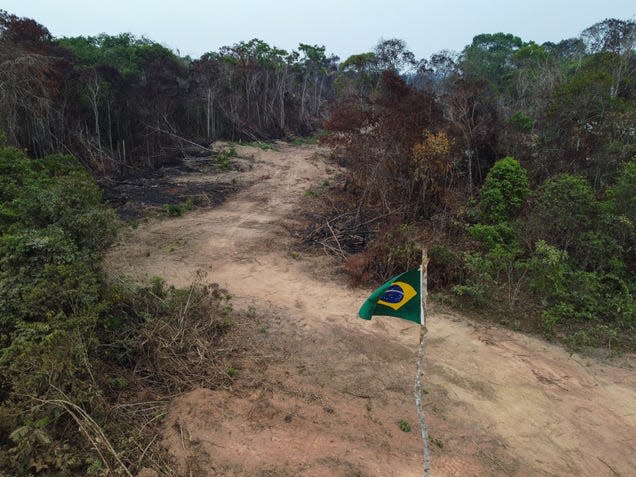Brazil’s election winner will play a key role in the climate crisis

As Brazilians go to the polls for the second round of the presidential election on Sunday (Oct. 30), they aren’t only choosing a new leader—they’re making a decision that will influence the global fight against climate change.
Since incumbent president Jair Bolsonaro performed better than polls predicted in the Oct. 2 vote, his chances of retaining power have improved. Support has grown thanks to his administration’s pro-business moves that have helped bring down consumer costs through tax cuts and reduce unemployment.
Read more
Bolsonaro’s record on tackling climate change is anything but positive. When the far-right leader was elected in 2018, Nature magazine warned that his stance promoting “development at all costs” would bode badly for the environment. On Oct. 25, the scientific journal once again rang alarm bells, citing that, in the Amazon alone, deforestation has nearly doubled since he came into power.
It’s unsurprising that the so-called Trump of the Tropics, whom critics condemned for a badly botching the country’s covid-19 response and fanning a dangerous gun culture, isn’t a poster child of climate action. But more than inaction, the Bolsonaro government played an active role in dismantling environmental protections, for instance slashing budgets and curbing the authority of federal agencies, and minimizing consequences for illegal logging. Under his watch, criminal agents have not only chopped down trees unlawfully but also threatened and killed forest defenders, including law enforcement agents and indigenous people.
In May, Bolsonaro finally took some steps towards tackling deforestation, by increasing fines for environmental crimes. Nonetheless, experts fear that another four years of Bolsonaro’s rule could irreparably damage the Amazon.
Why Brazil’s climate action matters to the world
Brazil is the largest economy, greenhouse gas emitter, and consumer of energy in South America, but the impact of its climate action reverberates across the world as the Amazon rainforest is one of the planet’s largest carbon sinks.
There’s an urgent need to protect the Amazon from further deforestation, as noted in an October 2021 communication to the Office of the Prosecutor of the International Criminal Court (ICC) by the NGO All Rise, which demanded a probe into the damage done by Bolsonaro.
In 2021, parts of the Amazon were found to be emitting more greenhouse gasses than it absorbed, largely due to fires ignited to clear land for agricultural use. Scientists estimate that around 17% of the forest’s area has been lost, and if destruction increases to 20-25%, the Amazon could reach a “tipping point” after which it would lose its ability to regenerate trees, and large areas would become savannah, affecting its ability to absorb carbon emissions.
If the destruction of the Amazon continues, the consequences include:
😶🌫️ worsening air quality;
🌡️ escalating risk of severe drought in Brazil and its neighboring countries (in 2021, Brazil has suffered its worst drought in 91 years);
🌳 losing the exceptional biodiversity of the Brazilian Legal Amazon’s flora and fauna. Its Biomes are the last refuge of creatures such as the jaguar and the pink dolphin, and a vital source of medicinal products and research;
🫁 an increase in serious respiratory disease, particularly for those living within the forest;
🌪️ an increase in the frequency and intensity of extreme weather events around the globe;
🦠 a heightened risk of “zoonotic spillover,” leading to more and worse pandemics.
Quotable
“What is at stake is the future of Brazil for the next generation of Brazilians and the planet’s climate stability,” —Ilona Szabó, co-founder of the Igarapé Institute think tank, who now lives abroad because of threats she received from supporters of Bolsonaro.
Bolsonaro’s Amazon damage, by the digits
60%: how much of the Amazon rainforest lies in Brazil
30 million: people who live in the Amazon, including almost 350 indigenous and ethnic groups
2 billion: trees felled in the Amazon during Bolsonaro’s four years as president. That’s 15 per second
20: environmental activists killed in Brazil in 2020 (The president has called environmental NGOs “cancers”)
10%: reduction in environment-related staffing in Bolsonaro’s government
22.5-23%: estimated loss of Amazon rainforest surface in the next eight years if Bolsonaro’s policies continue unchanged
1,500: new pesticides approved under Bolsonaro’s rule; many with ingredients which are banned in the EU
Person of Interest: Lula
Unlike his opponent Bolsenaro’s opponent, left-wing leader Luiz Inácio Lula da Silva (known as “Lula”) garnered immense goodwill for his welfare policies, leaving office with a 90% approval rating. He made strides in solving Brazil’s hunger crisis and redistributing wealth, lifting at least 20 million Brazilians out of poverty, when he was president between 2003 and 2010.
The septuagenarian couldn’t run for office in 2018 because of corruption and money laundering convictions the year prior. However, these were voided by the Brazilian Supreme Court in 2021, and now he’s back to finish what he started.
His win could be the respite Brazil’s ailing environment needs. During Lula’s last tenure, Amazon deforestation was down 70%. If he wins, an environmental policy overhaul—including tackling illegal logging, aiming for net-zero deforestation, and delivering on emissions targets—is on the table. He publicly committed to introducing carbon pricing and issuing new financial incentives for sustainable farming, among things.
Lula won more votes than Bolsonaro during the election’s first round, but failed to cross the 50% majority that would have given him a downright victory.
Related stories
🍃 The Nile Delta isn’t ready for climate change
🌎 Scientists have finally added world politics to their climate models
🇧🇷 Brazil’s Bolsonaro has his same old election fraud excuse ready if he loses
More from Quartz
Sign up for Quartz's Newsletter. For the latest news, Facebook, Twitter and Instagram.

